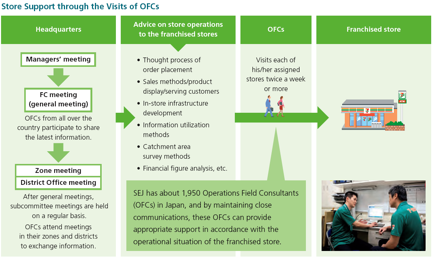Seven-Eleven Japan’s Business Model.
(http://www.7andi.com/dbps_data/_template_/_user_/_SITE_/localhost/_res/ir/library/ar/pdf/2012_11.pdf)
Introduction.
Since its establishment in 1973, Seven-Eleven Japan (SEJ) has always closely tracked changes in society and consumer lifestyles and has taken steps to enhance its own operations to meet emerging trends. SEJ continues to implement reforms to support continued progress.
A. Core Strategy.
i. Business Mission.
• Modernization and revitalization of existing small and medium-sized stores.
• Co-existence and co-prosperity.
ii. Product and Market Scope.
Original Product Development Framework.
• Store Network.
High-density, concentrated store openings are the foundation of high-value-added products and services.
Through the use of the market concentration strategy, SEJ has been able to establish a distribution system and implement product strategies that leverage the distinctive features of high store densities.
Moving forward, SEJ will continue working to open stores with a focus on quality. For example, SEJ will carefully consider the sites for new stores in accordance with strict conditions, thereby steadily enhancing profitability on a store-by-store basis.
B. Strategy Resources.
i. Core Competency.
Francais System.
Under the franchise system, business operations are divided between the headquarters and franchised stores. This system promotes coexistence and co-prosperity between SEJ and franchisees.
Aiming to “modernize and revitalize small and medium-sized retail stores,” SEJ is implementing an original franchise system. SEJ and franchisees are on an equal footing, and there is a clear division of roles. The gross profit splitting method is used for the division of profit. As a result, the focus is not on increasing sales but rather on increasing gross profit, fostering co-existence and co-prosperity among all parties.
ii. Strategic Assets.
Item-by-Item Management System.
• To implement item-by-item management, SEJ is building original information systems and distribution networks and is working to maximize the efficiency of store operations as well as profits.
• SEJ has built one of the world’s largest information networks, which links stores, headquarters, combined distribution centers, and suppliers.
• In addition, SEJ has established a combined distribution system that is managed by third parties. This is a practical system that offers logistics advantages for customers, franchised stores, and suppliers.
Advantages of Temperature-separated Combined Distribution System
Under SEJ’s combined distribution system, products from different suppliers and manufacturers are loaded onto the same truck and delivered to stores. With temperature-separated combined distribution, products are maintained at the appropriate temperature from supplier and manufacturer to store, facilitating the efficient delivery of fresh products to stores.
C. Patrnership Network.
i. Suppliers and Partners.
• SEJ’s ability to differentiate its operations from those of competitors is the result of a lineup of more than 1,000 original products.
• This lineup, which is SEJ’s greatest strength, is the key factor behind strong store loyalty.
• SEJ is working together with the Nihon Delica Foods Association* to develop original daily food products, which are SEJ’s core product.
• SEJ places a high priority on ensuring that the production facilities and distribution centers for its original daily food products are used only by SEJ. This enables SEJ to differentiate itself in the areas of product development, food safety management, and quality control.
* Nihon Delica Foods Association: Established in 1979, centered on manufacturers of rice-based products. Currently, about 80 companies are participating in the association, including makers of rice-based products, bakery products, delicatessen items, noodles, and Japanese pickles. The association is implementing initiatives in such areas as product development, quality control, joint procurement, and environmental countermeasures.
D. Customer Interface.
i. Target Customer.
Customer age between 13 to 24 years old.
ii. Fulfillment and Support.
Service Development.
• SEJ is aiming to meet customer needs with an expanded range of services and to increasingly offer “close by convenient stores.”
• To make its stores a part of the daily lifestyle infrastructure, SEJ has expanded its range of services that are useful in daily life. A diverse range of SEJ services contributes to growth in the number of customer store visits. These services include ATM services, the acceptance of bill payments, meal delivery services, and ticket services provided with the use of multi-function copiers.
iii. Pricing Structure.
(http://www.7andi.com/dbps_data/_template_/_user_/_SITE_/localhost/_res/ir/library/ar/pdf/2012_11.pdf)
Introduction.
Since its establishment in 1973, Seven-Eleven Japan (SEJ) has always closely tracked changes in society and consumer lifestyles and has taken steps to enhance its own operations to meet emerging trends. SEJ continues to implement reforms to support continued progress.
A. Core Strategy.
i. Business Mission.
• Modernization and revitalization of existing small and medium-sized stores.
• Co-existence and co-prosperity.
ii. Product and Market Scope.
Original Product Development Framework.
iii. Basic for Differences.
• Store Network.
High-density, concentrated store openings are the foundation of high-value-added products and services.
Through the use of the market concentration strategy, SEJ has been able to establish a distribution system and implement product strategies that leverage the distinctive features of high store densities.
Moving forward, SEJ will continue working to open stores with a focus on quality. For example, SEJ will carefully consider the sites for new stores in accordance with strict conditions, thereby steadily enhancing profitability on a store-by-store basis.
B. Strategy Resources.
i. Core Competency.
Francais System.
Under the franchise system, business operations are divided between the headquarters and franchised stores. This system promotes coexistence and co-prosperity between SEJ and franchisees.
Aiming to “modernize and revitalize small and medium-sized retail stores,” SEJ is implementing an original franchise system. SEJ and franchisees are on an equal footing, and there is a clear division of roles. The gross profit splitting method is used for the division of profit. As a result, the focus is not on increasing sales but rather on increasing gross profit, fostering co-existence and co-prosperity among all parties.
ii. Strategic Assets.
Item-by-Item Management System.
• To implement item-by-item management, SEJ is building original information systems and distribution networks and is working to maximize the efficiency of store operations as well as profits.
• SEJ has built one of the world’s largest information networks, which links stores, headquarters, combined distribution centers, and suppliers.
• In addition, SEJ has established a combined distribution system that is managed by third parties. This is a practical system that offers logistics advantages for customers, franchised stores, and suppliers.
Advantages of Temperature-separated Combined Distribution System
Under SEJ’s combined distribution system, products from different suppliers and manufacturers are loaded onto the same truck and delivered to stores. With temperature-separated combined distribution, products are maintained at the appropriate temperature from supplier and manufacturer to store, facilitating the efficient delivery of fresh products to stores.
C. Patrnership Network.
i. Suppliers and Partners.
• SEJ’s ability to differentiate its operations from those of competitors is the result of a lineup of more than 1,000 original products.
• This lineup, which is SEJ’s greatest strength, is the key factor behind strong store loyalty.
• SEJ is working together with the Nihon Delica Foods Association* to develop original daily food products, which are SEJ’s core product.
• SEJ places a high priority on ensuring that the production facilities and distribution centers for its original daily food products are used only by SEJ. This enables SEJ to differentiate itself in the areas of product development, food safety management, and quality control.
* Nihon Delica Foods Association: Established in 1979, centered on manufacturers of rice-based products. Currently, about 80 companies are participating in the association, including makers of rice-based products, bakery products, delicatessen items, noodles, and Japanese pickles. The association is implementing initiatives in such areas as product development, quality control, joint procurement, and environmental countermeasures.
D. Customer Interface.
i. Target Customer.
Customer age between 13 to 24 years old.
ii. Fulfillment and Support.
Service Development.
• SEJ is aiming to meet customer needs with an expanded range of services and to increasingly offer “close by convenient stores.”
• To make its stores a part of the daily lifestyle infrastructure, SEJ has expanded its range of services that are useful in daily life. A diverse range of SEJ services contributes to growth in the number of customer store visits. These services include ATM services, the acceptance of bill payments, meal delivery services, and ticket services provided with the use of multi-function copiers.
iii. Pricing Structure.




















_A3.jpg)


















